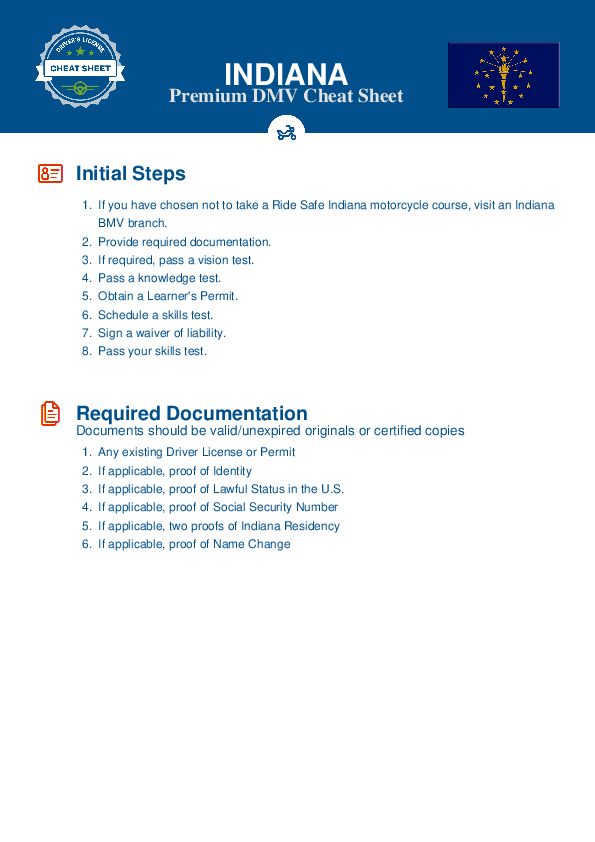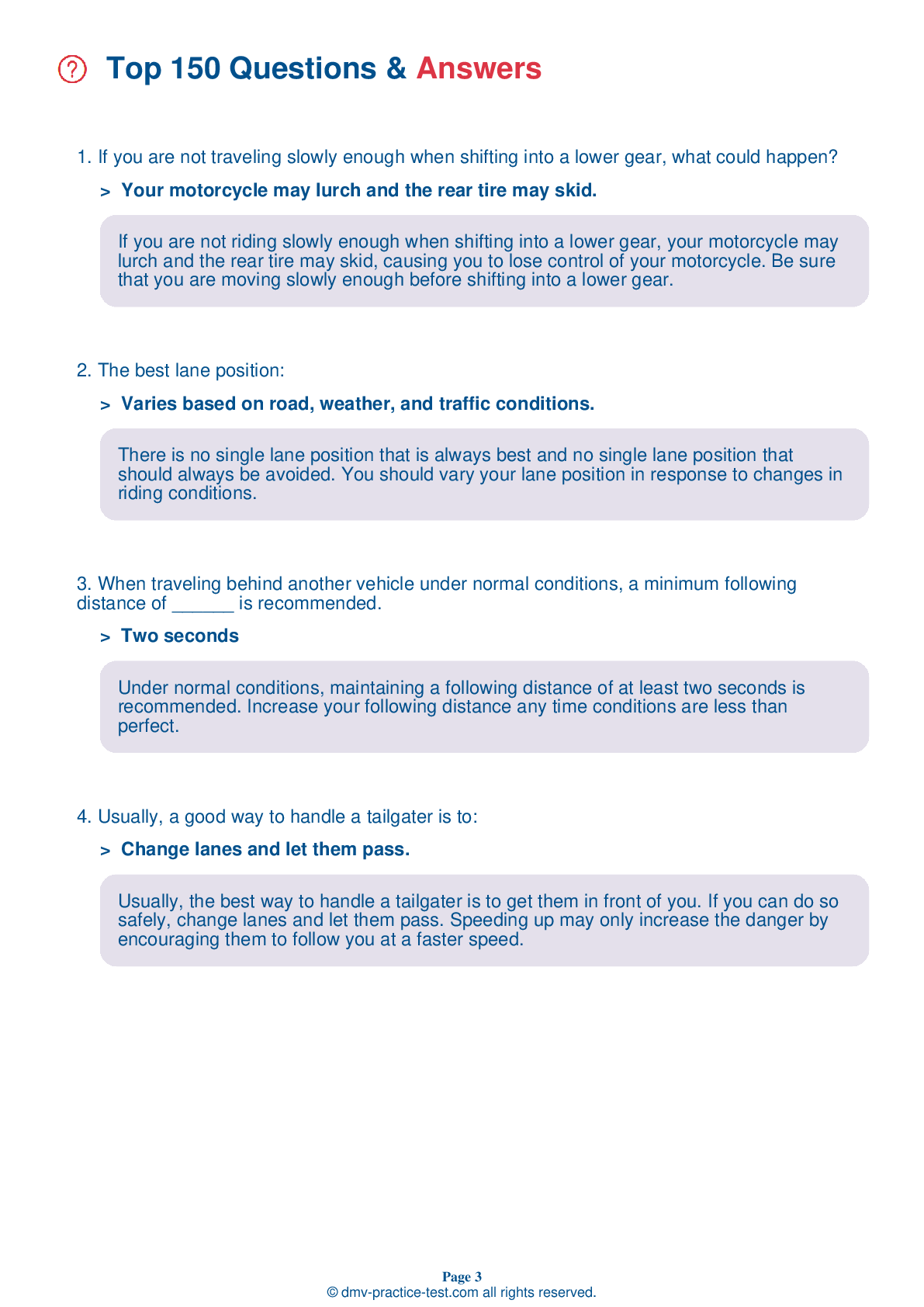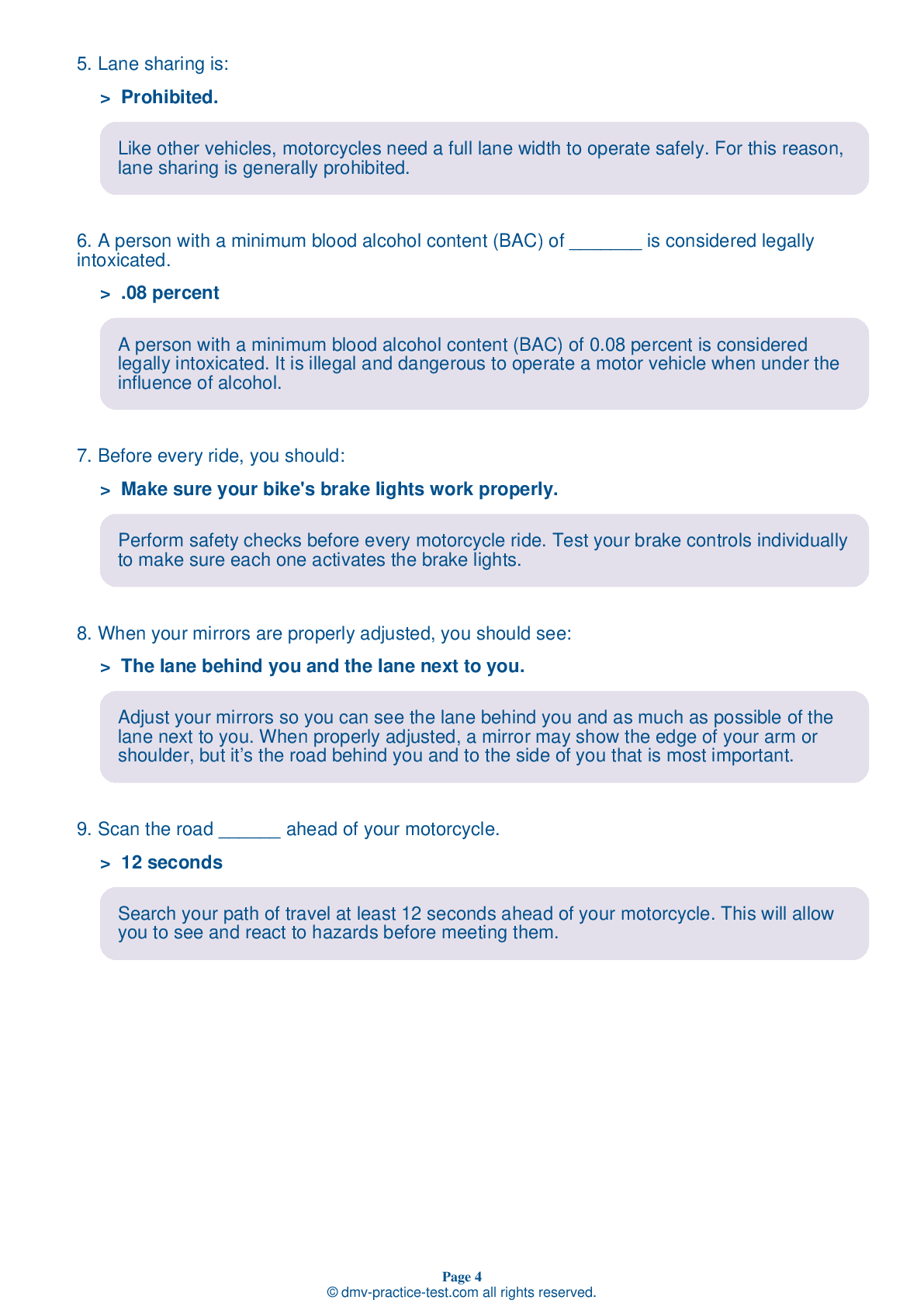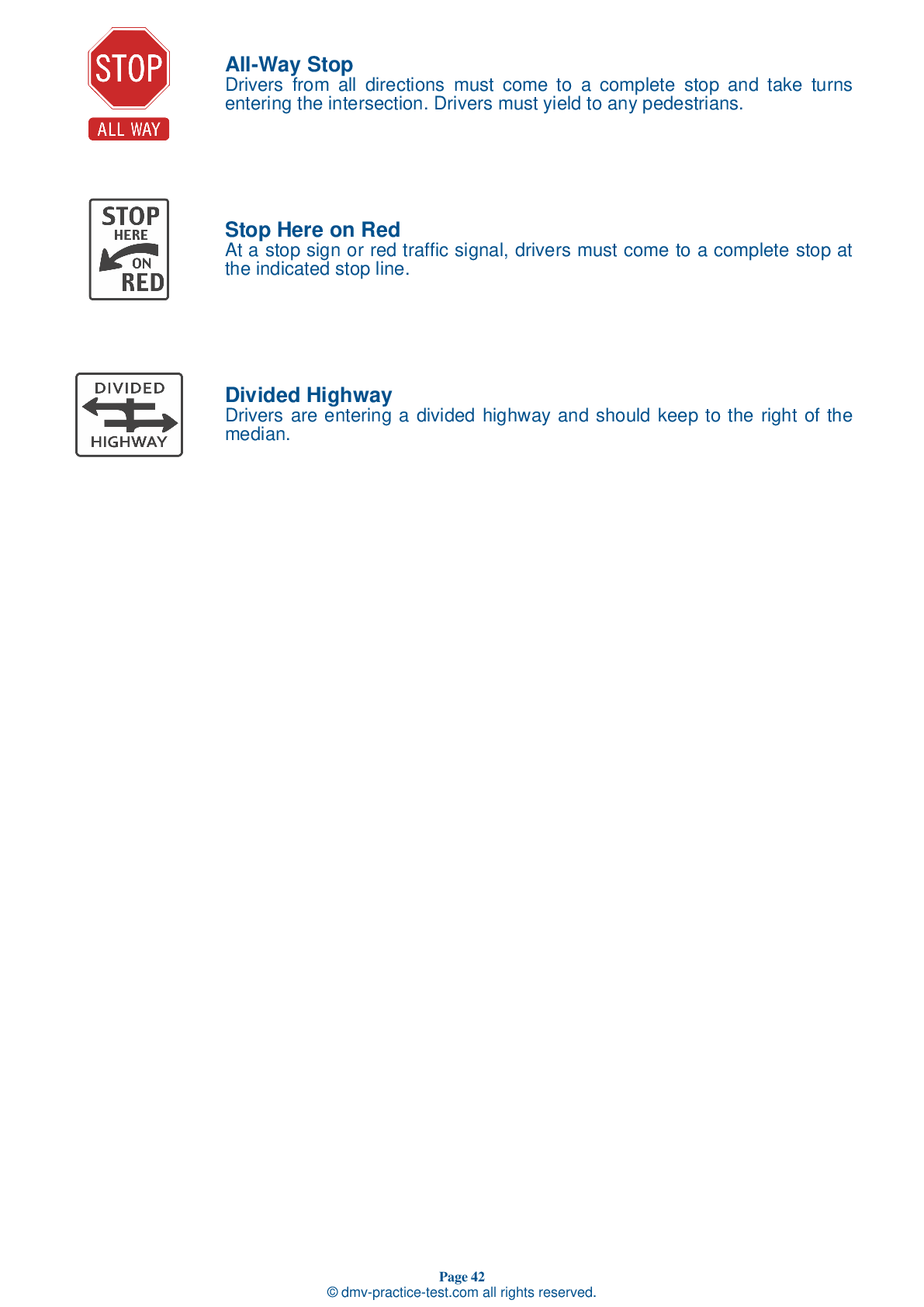DMV Permit Test #13
Motorcycle Test | License IN 2025 | FREE Online Practice! #13 Page 2 of 4
Take this FREE motorcycle test (license in IN 2025) to check your knowledge of the road rules. To improve your results, download a motorcycle handbook online, study theory, and practice for free on our website. Still worried about how to get a motorcycle license in Indiana in 2025? Check our website for more sample tests, train as much as possible, and boost your grades!
25
21
16
7 . When upshifting, the first thing you should do is:
Roll off the throttle and release the clutch lever.
When upshifting, you should first roll off the throttle as you squeeze the clutch lever. Next, lift the shift lever firmly as far as it will go. Smoothly ease out the clutch and roll on the throttle as you complete the gear shift.
8 . Mirror checks:
Are only recommended in bad weather.
For your safety, it is important to be aware of what's behind you. Frequent mirror checks should be a part of your normal searching routine.
9 . Because of their small size, motorcycles seem to be:
Closer than they actually are.
Because of their size, motorcycles may seem to be traveling faster than they actually are.
10 . When you are being passed by another vehicle, which part of the lane should you ride in?
It doesn’t matter.
When being passed, it is generally safest to ride in the center portion of your lane. Riding on the side nearest the passing vehicle increases the risk of colliding with them. Riding on the side farthest from the passing vehicle is also dangerous, as it could tempt the driver to re-enter your lane before it is safe to do so.
11 . Riding at night is usually:
Less distracting than riding during the day.
Riding safely at night is challenging because it is harder to see and be seen than it is during the day. The absence of normal shadows and light contrasts makes it harder to judge distances.
12 . Making eye contact with other drivers:
Is not worth the effort it takes.
You should not rely on eye contact to guarantee that a driver will yield to you. It is not uncommon for a driver to look directly at a motorcyclist and still fail to actually notice them.
Need Motorcycle Insurance? No problem!
Compare the best rates in Indiana and find a personalized policy that meets your needs.
1. Are You Currently insured ?
2. Married ?
3. Do you own your Home?
4. Have you or a Family Member Honorably Served in U.S. Military ?
5. Your Name
6. Age
7. Zip code
Ranked by best match
2025 Indiana | Frequently Asked Questions
To acquire a motorcycle license in Indiana, you must first hold a valid Indiana driver's license. Then, you'll need to pass a written motorcycle knowledge exam and a motorcycle skills exam. Alternatively, you can complete a state-approved motorcycle safety course which often waives the skills test requirement. You must also pay the necessary fees to receive your motorcycle endorsement.
In Indiana, the minimum age to obtain a motorcycle driver's license is 16 years and 90 days. However, before getting a full endorsement, riders under the age of 18 must hold a valid motorcycle learner's permit for at least 30 days and must successfully complete a state-approved motorcycle safety course.
Yes, you do need a dedicated license for motorcycle riding in Indiana. This is known as a motorcycle endorsement and it is added to your regular driver's license. To obtain this endorsement, you must pass a written test and a riding skills test. Alternatively, completion of an approved motorcycle safety course can waive these testing requirements.
To apply for a motorcycle driver's license in Indiana, you'll need the following documents: proof of identity (like a birth certificate or passport), proof of Social Security number, proof of lawful status in the U.S., and two proofs of Indiana residency. If you're under 18, you'll also need a legal guardian's consent and proof of enrollment in school.
Yes, you will need to take a written exam to get a motorcycle license in Indiana. The exam covers topics such as traffic laws, road signs, and safe riding techniques. However, if you successfully complete an approved motorcycle rider education course, the written and skills tests may be waived.
The motorcycle written test in Indiana covers various subjects related to motorcycle safety and operation. Topics include traffic laws, road signs, safe riding techniques, handling dangerous situations, and motorcycle maintenance. The test also covers protective gear, passenger rules, and alcohol/drug effects on riding. Studying the Indiana Motorcycle Operator Manual is recommended to prepare for the test.
Yes, in Indiana, completing a state-approved motorcycle safety course can substitute for the written and skills tests required for a motorcycle endorsement. The course includes classroom instruction and hands-on training. Upon successful completion, you'll receive a waiver for the BMV tests. However, you still need to apply in-person at a BMV branch to add the endorsement to your license.
To enroll in a motorcycle training course in Indiana, first, find a state-approved course provider. Then, sign up either online or by phone. Courses usually require payment upfront. You'll need a valid driver's license or learner's permit. Some courses provide motorcycles and helmets, but check with the provider. Once enrolled, attend all sessions and successfully complete the course to receive certification.
No, you do not need to own a motorcycle to take the license test in Indiana. You can use a borrowed motorcycle, as long as it is street-legal, properly insured and registered. However, the motorcycle must be appropriate for your size and skill level. Remember to bring a helmet and eye protection for the test.
Yes, you can use a friend's motorcycle for your driver's license evaluation in Indiana, provided the motorcycle is street-legal, registered, insured, and you have permission to use it. It must also meet all safety requirements and be appropriate for your size and skill level. You'll also need a helmet and protective eyewear.
Yes, in Indiana, the motorcycle driving exam tests specific handling skills. These include left and right turns, swerving, quick stops, cone weaving, and U-turns. The test evaluates the rider's ability to control the motorcycle, make safe riding decisions, and apply Indiana's traffic laws. The skills test is designed to ensure motorcyclists can operate their vehicles safely on the road.
Yes, in Indiana, new motorcycle drivers under the age of 18 must first obtain a motorcycle learner's permit. This permit has restrictions such as no nighttime riding, no passengers, and no interstate riding. After 30 days of maintaining a learner's permit, they can apply for a motorcycle endorsement or license.
Yes, your Indiana driver's license with a motorcycle endorsement allows you to operate a motorcycle in other states. However, it's important to note that you must abide by the traffic laws of the state you are in, which may differ from those in Indiana. Always check local laws when traveling out of state.
In Indiana, state law requires all motorcycle riders under the age of 18 to wear a helmet and eye protection. However, riders aged 18 and over are not legally required to wear a helmet. Despite this, it's highly recommended for all riders to wear a helmet for their safety, as it greatly reduces the risk of head injuries.
Yes, Indiana offers two types of motorcycle licenses: a motorcycle-only license and a motorcycle endorsement. The motorcycle-only license allows you to only operate a motorcycle, while the motorcycle endorsement can be added to a valid Indiana driver's license, permitting you to operate both a motor vehicle and a motorcycle.
Yes, you can add supplementary endorsements to your motorcycle license in Indiana. These endorsements allow you to operate different types of motorcycles. However, each endorsement may require additional testing. It's recommended to check with the Indiana Bureau of Motor Vehicles for specific requirements related to the endorsement you want to add.
Yes, in Indiana, the motorcycle written test is available in several languages other than English. This is to accommodate a diverse range of applicants. However, it's advisable to contact your local BMV branch beforehand to confirm the availability of the test in your preferred language.
An effective strategy to prepare for the motorcycle license test in Indiana is to study the Motorcycle Operator Manual, which is available online or at any BMV branch. The manual covers all the information you need. Also, taking online practice tests can be beneficial as they familiarize you with the format and type of questions on the actual test. Remember to get enough rest before your test day.
Yes, the motorcycle written exam in Indiana can be taken in several languages other than English. The Bureau of Motor Vehicles (BMV) offers the exam in 14 different languages. However, it's recommended to contact your local BMV branch ahead of time to ensure your preferred language is available.
Yes, retaking is allowed if you don't pass the motorcycle written test in Indiana. After failing, you need to wait at least one day before retaking the test. However, if you fail the test three times, you must wait two months from the date of the last failed test before attempting again. It's advisable to study thoroughly to improve your chances of passing.



